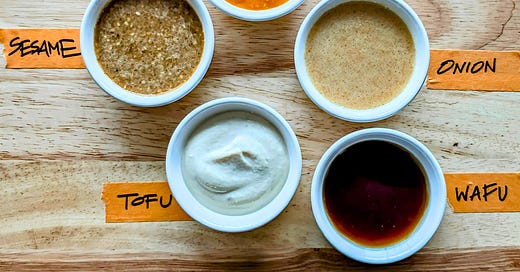I haven’t always been a fan of salads. I blame that on my childhood where “salad” meant a side bowl of iceberg lettuce coated in thick, gloopy Thousand Island dressing from a bottle. Lucky for me, no one seemed to care if I pushed it aside untouched or even skipped it altogether.
Fast forward to sushi school in LA. Day 5, to be exact. We spent an entire class learning about Japanese-style dressings and sauces. These were the kinds of dressings that show up on sushi bar menus quietly as supporting players, meant to enhance the fresh, simple flavors of the food without overpowering them. Definitely nothing like the loud, boisterous ones I remembered from childhood.
At some point, one of my classmates brought up Ginger Dressing. I hadn’t tried it before, so I listened quietly, hoping to gain some insight and avoid exposing my unsophisticated Thousand Island palate. Some of my classmates laughed. Apparently, this was seen as a lowbrow, guilty pleasure. The kind of thing you’d find in a neighborhood spot. Not the high-end, swanky places we all aspired to work in, where the salads would surely be dressed traditionally or in vinaigrettes inspired by Japanese flavors.
During the break that day, Assistant Sensei disappeared for a while then returned with a little takeout container. I opened it and found a small, salad: chopped iceberg lettuce, a few bits of shredded carrot and red cabbage, and a couple of tomato wedges clinging to the sides, all coated in a thick, orange dressing. I hesitated for a moment, because it looked so similar to the salads I loathed as a kid.
But I was delighted after the first bite. It was a revelation. Wonderfully gingery, a little sweet, perfectly zippy, and surprisingly light despite its thick appearance. It was completely different from anything I’d ever had.
Turns out, I didn’t hate salads. I just didn’t know how much of a difference a good, homemade dressing could make.
Japanese-Style Dressings
When it comes to Japanese-style dressings, simplicity is key. These dressings are often built on a handful of foundational ingredients – soy sauce, rice vinegar, sesame seed oil – chosen for their ability to enhance without overpowering. It’s a minimalist approach that highlights the natural flavors of the other ingredients in a dish.
Of the five dressings in this guide, four lean toward the more traditional side, relying on these classic flavors for balance and depth. I decided to also include Ginger Dressing. It’s a bit of a rebel, with a decidedly untraditional ingredient: ketchup. (Although you might be surprised to learn that ketchup actually shows up quite a bit in modern Japanese cuisine.)
Ingredient Spotlight : Rice Vinegar
Rice vinegar is my preferred vinegar for almost everything. It’s a pantry staple in Japanese cooking, prized for its bright, slightly sweet flavor and subtle acidity. Made from fermented rice, it has a milder taste than Western vinegars, making it perfect for dressings, marinades, quick pickles, and of course, sushi.
When shopping for rice vinegar, look for plain, unseasoned varieties. The ingredients list should just be rice and water. Using pre-seasoned rice vinegar will throw off the balance of these dressings, making them much too sweet and salty.
5 Japanese-Style Dressings


In the Japanese-style Dressings PDF, you’ll find the full recipes for each dressing, along with one of my favorite salad recipes to pair with each one. But don’t let the word “dressing” fool you. These are great for more than just greens. Use them as marinades for grilled vegetables or proteins, drizzle them over grain bowls, as a dipping sauce for spring rolls, or toss them with noodles for a quick, flavor-packed meal.
Ginger Dressing
The popular orange salad dressing often served in neighborhood Japanese restaurants. Though not traditional, this made-from-scratch version deserves a place in your salad dressing rotation.
Salad: Wedge Salad with Ginger Dressing
Wafu Dressing
This dressing clings beautifully to tender greens and adds a hit of savory depth without overpowering the other ingredients.
Salad: Gyoza Salad
Sesame Dressing
This dressing has a deep, roasted flavor and pairs beautifully with noodles and hearty vegetables.
Salad: Sesame Noodle Salad
Onion Dressing
Raw onions may not be the first ingredient you’d think to use for a dressing, but I’ll ask you to trust the process. The end result is surprisingly mild…but you’ll still need an after dinner mint.
Salad: Corn & Edamame Cobb Salad
Tofu Dressing
Just as it sounds, the main ingredient in this creamy dressing is tofu. It has just enough richness to coat your salad, but still feels light and fresh. It can also double as a dip for raw veggies.
Salad: Blanched Broccoli Salad
Get all the recipes in the download.








Can't wait to try, especially the onion and tofu - so light and simple! Thanks 💐